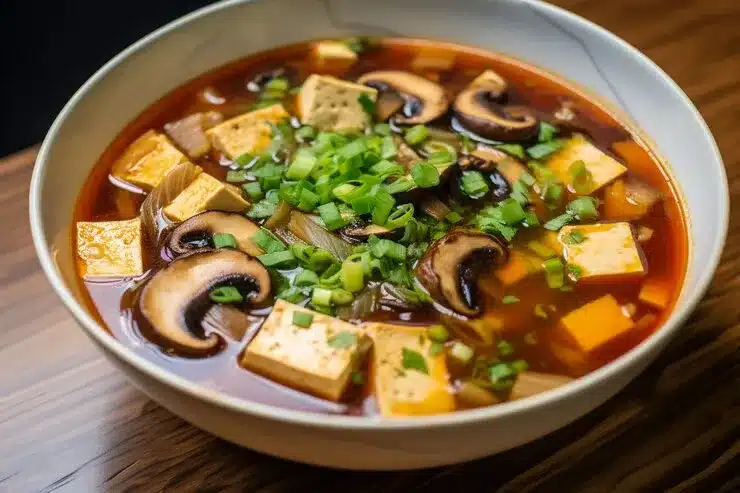Tofu mushroom green onion soup is inspired by traditional Japanese cuisine, known for its emphasis on simplicity, seasonal ingredients, and balanced nutrition. Tofu, a staple in Japanese cooking, is prized for its versatility and high protein content. Mushrooms add umami, a deep savory flavor, while green onions provide a fresh, aromatic note. This soup is often enjoyed as part of a Japanese meal, offering both comfort and nourishment, particularly during colder months.
Ways to Pair It
This soup is incredibly versatile and can be served in various ways to complement different meals:
- As an Appetizer: Serve a small bowl of this soup as a warm and inviting start to a multi-course Japanese meal.
- With Rice: Pair the soup with a bowl of steamed white or brown rice for a more filling meal.
- With Sushi or Sashimi: This light soup pairs beautifully with sushi or sashimi, balancing the flavors and providing a comforting contrast to the raw fish.
- With Tempura: The light and crispy texture of tempura contrasts nicely with the warm, savory soup, making for a satisfying meal combination.
- In a Bento Box: Include a small portion of this soup in a traditional bento box lunch, alongside other favorites like pickled vegetables and grilled fish.
Ingredients
- For the Soup Base:
- 4 cups of vegetable or chicken broth
- 1 tablespoon of soy sauce
- 1 teaspoon of sesame oil (optional)
- 1 clove of garlic, minced
- 1-inch piece of ginger, thinly sliced
- For the Soup:
- 200 grams of tofu, cubed (firm or silken, depending on your preference)
- 1 cup of mushrooms, sliced (shiitake, enoki, or button mushrooms)
- 2 green onions, chopped
- 1 tablespoon of miso paste (optional, for added depth of flavor)
- Salt and pepper to taste
- Optional garnish: sesame seeds, nori strips, or chili flakes
Preparation
- Prepare the Soup Base:
- In a large pot, heat the broth over medium heat. Add the minced garlic and sliced ginger, allowing them to infuse the broth with flavor.
- Stir in the soy sauce and sesame oil. Let the mixture simmer for about 5 minutes, so the flavors meld together.
- Add the Mushrooms:
- Add the sliced mushrooms to the pot and cook for another 5-7 minutes, until the mushrooms are tender and have released their juices.
- Add the Tofu and Green Onions:
- Gently stir in the cubed tofu and chopped green onions. If using miso paste, dissolve it in a small amount of warm broth before adding it to the pot to ensure it blends smoothly.
- Simmer for another 3-5 minutes to warm the tofu and allow the green onions to soften slightly.
- Season and Serve:
- Taste the soup and adjust the seasoning with salt and pepper if needed.
- Serve hot, garnished with sesame seeds, nori strips, or a pinch of chili flakes for added flavor and texture.
Tips
- Tofu Texture: For a heartier texture, use firm tofu. If you prefer a softer, creamier texture, opt for silken tofu.
- Mushroom Varieties: Shiitake mushrooms offer a rich umami flavor, while enoki mushrooms add a delicate texture. Feel free to mix and match different types of mushrooms based on availability and preference.
- Miso Paste: Adding miso paste gives the soup an extra layer of depth and enhances its umami profile. Make sure to dissolve the miso in warm broth before adding it to the soup to avoid clumps.
- Customization: This soup can be easily customized with additional vegetables like spinach, bok choy, or carrots. You can also add a soft-boiled egg for extra protein and richness.
- Make it a Meal: To make this soup more substantial, consider adding cooked soba or udon noodles to the broth.
Finding It in Restaurants
This type of soup can often be found in Japanese restaurants, particularly those that focus on traditional dishes or offer a variety of soups and noodle bowls. Here are a few places where you might find it:
- Japanese Izakayas: These casual eateries often serve tofu and mushroom-based soups as part of their menu.
- Ramen Shops: While ramen is the star, many ramen shops offer a variety of soups that include tofu, mushrooms, and green onions as part of their offerings.
- Sushi Restaurants: High-end sushi restaurants sometimes include this type of soup in their menu as a lighter option to accompany sushi or sashimi.
- Vegetarian and Vegan Restaurants: As this soup is easily adaptable to vegetarian and vegan diets, it’s frequently featured in vegetarian-friendly Japanese or Asian fusion restaurants.





